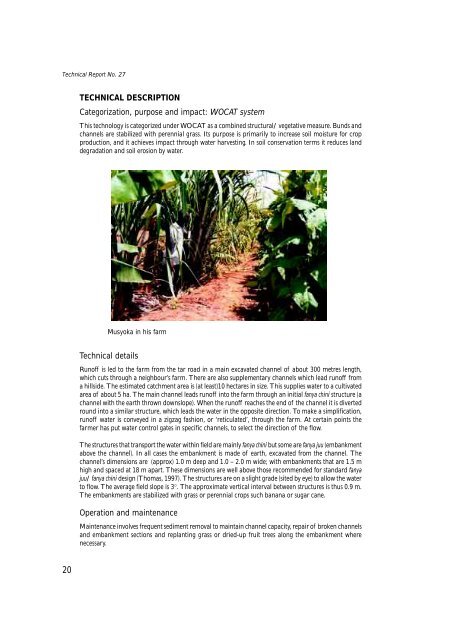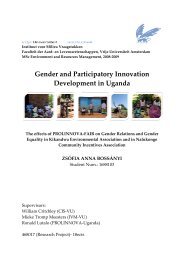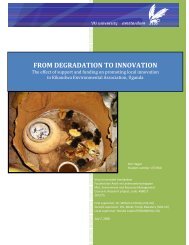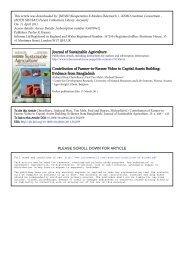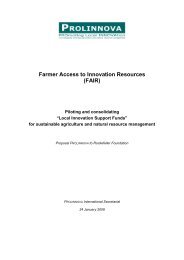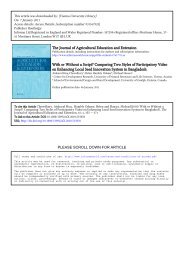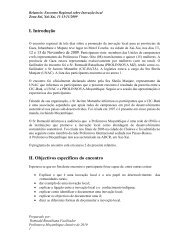Farmers' initiatives in land husbandry: promising ... - Prolinnova
Farmers' initiatives in land husbandry: promising ... - Prolinnova
Farmers' initiatives in land husbandry: promising ... - Prolinnova
You also want an ePaper? Increase the reach of your titles
YUMPU automatically turns print PDFs into web optimized ePapers that Google loves.
Technical Report No. 27<br />
TECHNICAL DESCRIPTION<br />
Categorization, purpose and impact: WOCAT system<br />
This technology is categorized under WOCAT as a comb<strong>in</strong>ed structural/ vegetative measure. Bunds and<br />
channels are stabilized with perennial grass. Its purpose is primarily to <strong>in</strong>crease soil moisture for crop<br />
production, and it achieves impact through water harvest<strong>in</strong>g. In soil conservation terms it reduces <strong>land</strong><br />
degradation and soil erosion by water.<br />
Musyoka <strong>in</strong> his farm<br />
Technical details<br />
Runoff is led to the farm from the tar road <strong>in</strong> a ma<strong>in</strong> excavated channel of about 300 metres length,<br />
which cuts through a neighbour’s farm. There are also supplementary channels which lead runoff from<br />
a hillside. The estimated catchment area is (at least)10 hectares <strong>in</strong> size. This supplies water to a cultivated<br />
area of about 5 ha. The ma<strong>in</strong> channel leads runoff <strong>in</strong>to the farm through an <strong>in</strong>itial fanya ch<strong>in</strong>i structure (a<br />
channel with the earth thrown downslope). When the runoff reaches the end of the channel it is diverted<br />
round <strong>in</strong>to a similar structure, which leads the water <strong>in</strong> the opposite direction. To make a simplification,<br />
runoff water is conveyed <strong>in</strong> a zigzag fashion, or ‘reticulated’, through the farm. At certa<strong>in</strong> po<strong>in</strong>ts the<br />
farmer has put water control gates <strong>in</strong> specific channels, to select the direction of the flow.<br />
The structures that transport the water with<strong>in</strong> field are ma<strong>in</strong>ly fanya ch<strong>in</strong>i but some are fanya juu (embankment<br />
above the channel). In all cases the embankment is made of earth, excavated from the channel. The<br />
channel’s dimensions are (approx) 1.0 m deep and 1.0 – 2.0 m wide; with embankments that are 1.5 m<br />
high and spaced at 18 m apart. These dimensions are well above those recommended for standard fanya<br />
juu/ fanya ch<strong>in</strong>i design (Thomas, 1997). The structures are on a slight grade (sited by eye) to allow the water<br />
to flow. The average field slope is 3°. The approximate vertical <strong>in</strong>terval between structures is thus 0.9 m.<br />
The embankments are stabilized with grass or perennial crops such banana or sugar cane.<br />
Operation and ma<strong>in</strong>tenance<br />
Ma<strong>in</strong>tenance <strong>in</strong>volves frequent sediment removal to ma<strong>in</strong>ta<strong>in</strong> channel capacity, repair of broken channels<br />
and embankment sections and replant<strong>in</strong>g grass or dried-up fruit trees along the embankment where<br />
necessary.<br />
20


